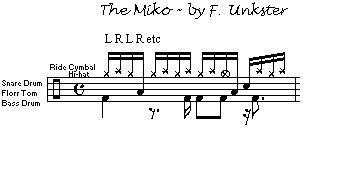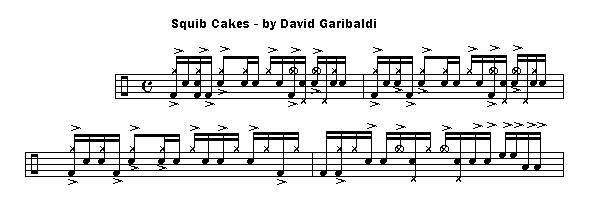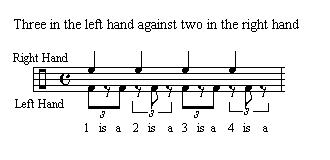

This page contains grooves, patterns, and exercises which I particularly
like. Some of the grooves are original while others are by some of my favorite
drummers. My transcriptions and MP3's of other drummers grooves are simply meant
to pique the curiousity. The performances are not meant to be definitive. It's
hoped that people will seek out the original recordings.
The sound clips require an MP3 player. I recommend the shareware version of
MusicMatch Jukebox 4.0.
Click this link to download MusicMatch Jukebox now.
MusicMatch Jukebox.
A word about the sound clips: They were all made with a single inexpensive
microphone run directly into a PC sound card. The original sound clips were
recorded as WAV files and later converted to MP3's.
Enjoy!
The Miko Groove
This groove was created to demonstrate a pattern utilizing the left hand on the hi-hat and snare
drum. The right hand plays the ride cymbal and toms. The first tom note is
sometimes played on the small tom. The last bass drum note is often omitted.
This feel is vaguely reminiscent of Steve Gadd.

The Miko Groove MP3 sound clip
Squib Cakes
This groove is by David Garibaldi
from the Tower of Power album entitled Back to Oakland. This groove is one of
my favorites. In fact the whole album is great. Highly recommended.

Half-time Shuffle (aka The "Purdie" Shuffle)
This is the groove popularized by Bernard "Pretty" Purdie. It's been used by
many other drummers such as Jeff Porcaro, Dave Weckl, David Garibaldi, etc..
This is a fantastic groove that everyone should be familiar with. A great
example of this groove is Bernard Purdie on the Steely Dan tune,
Babylon Sisters.
Ex. 1 uses rim-clicks on the snare drum. Notice the accents on the third beat
of each measure. All the other snare drum notes should be played very
softly.

Ex. 2 is a little busier version. Once again the snare accents on count three.
The ghost notes fill in a bit more giving this version a busier feel.

This accompanying MP3 is a little longer than the others so it may take a few
minutes to download.
Half-time Shuffle MP3 sound clip
Three Against Two
This pattern demonstrates how to play the polyrhythm 3-against-2. The right
hand plays a straight quarter-note pattern while the left hand plays every
other note of an eighth-note triplet pattern. The sound clip demonstrates the
example as written and then demonstrates the 3-against-2 polyrhythm in a jazz
context at various tempos.
(Note: See the Understanding Polyrhythms article
for more information.)

Three-Against-Two MP3 sound clip
Afro-Cuban 6/8
This is a very popular groove. It lends itself to jazz, fusion, funk, and of
course Latin styles.
The first notated example shows the Afro-Cuban cowbell written in 6/8 time.
This is the way it would traditionally be played.


Samba
This is another very popular groove which also lends itself to jazz, fusion,
funk and Latin styles. The samba is sort of like a Brazilian version of jazz.
It lends itself to a lot of interpretations. The overall feel shouldn't be
heavy or ponderous. Think of a graceful approach. One frequently overlooked
nuance is the accented bass drum note on 2 and 4 (or just on 2 if you are
thinking in cut-time). This gives the groove a very distinct forward motion.
The samba should 'swing'. I make no claim to the 'authenticity' of the samba
patterns given here. To get to the real essence of samba you should listen to
masters such as Airto. The MP3 starts with a medium tempo samba with the right
hand playing the snare drum. It then demonstrates the pattern using cross
stick and tom tom notes. Finally it shifts into double time combining the
samba foot pattern with a quasi-jazz cymbal rhythm.
